Excitement peeing can be frustrating for dog owners, but with proper training, it can be eliminated. Through a combination of behavior modification techniques and consistent routines, you can teach your dog to control their urinary functions and prevent accidents. In this article, we will provide you with expert tips and techniques to train your dog not to excitedly pee, including dog training tips, techniques to prevent urine marking, ways to control excitement peeing, and housebreaking techniques to eliminate submissive urination accidents.
- Proper training can eliminate excitement peeing in dogs.
- Behavior modification techniques and consistent routines are key to preventing accidents.
- Effective training requires patience and persistence.
- Socialization and confidence-building can help reduce excitement peeing.
- Consulting a professional trainer or behaviorist can be beneficial in some cases.
Understanding Excited Peeing in Dogs
Excited Peeing is a common issue among many dogs, particularly puppies. Dogs may exhibit excitement peeing when they are greeted by their owners, unfamiliar humans or animals or during playtime. This is a natural response as they release their pent-up energy and excitement.
Submissive Urination, on the other hand, is similar to excitement peeing, but it occurs as a result of fear or anxiety. Dogs may display submissive urination when they encounter unfamiliar people or dogs or when they are scolded or punished. This behavior is an instinctive way for dogs to show their submission to a dominant figure, and it is common in puppies or rescued dogs.
Both excited peeing and submissive urination can be managed through behavior modification strategies. Understanding the underlying causes of these behaviors is crucial to successfully addressing them.
Controlling dog excitement peeing requires consistent training and management techniques. One approach to preventing excited peeing is to manage your dog’s excitement levels. This can be done through desensitization and counterconditioning techniques, which will be discussed later in this article.
Dog behavior modification is essential when dealing with submissive urination. In order to eliminate this behavior, it is important to build your dog’s confidence and establish a routine that avoids triggering situations. Socialization, positive reinforcement, and consistency are key factors in behavior modification.
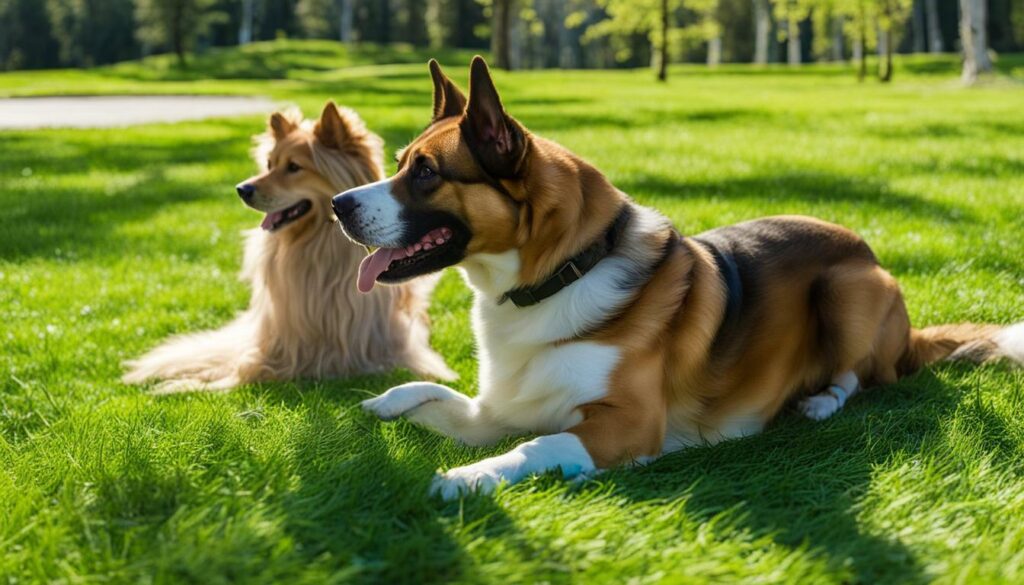
By understanding the underlying causes behind your dog’s excited peeing or submissive urination behaviors, you can begin to effectively manage and modify these behaviors through consistent training and management techniques. The following sections will provide you with the necessary guidance to help you train your dog not to excitedly pee, control their excitement levels, and eliminate submissive urination.
Setting Realistic Training Expectations
When it comes to training your dog not to excitedly pee, it’s important to set realistic expectations. This means understanding that training requires time, effort, and patience. It’s also important to recognize that each dog is different, and what may work for one dog may not work for another. Here are some dog training tips to help you set realistic expectations:
- Establish consistent routines: Setting consistent routines will help your dog learn what is expected of them and will make training easier. For example, establish a consistent feeding schedule and take your dog out for potty breaks at the same times every day.
- Understand your dog’s individual needs: Every dog is unique and has different needs and limitations. Take the time to understand your dog’s personality, habits, and preferences, and tailor your training approach accordingly.
- Be patient: Dogs learn at their own pace, so be patient with the training process. It may take some time for your dog to understand and adopt new behaviors.
- Don’t expect perfection: While the goal of training is to eliminate accidents, it’s important to accept that accidents may occur from time to time. Don’t get discouraged if your dog has an accident, and instead focus on reinforcing positive behaviors.
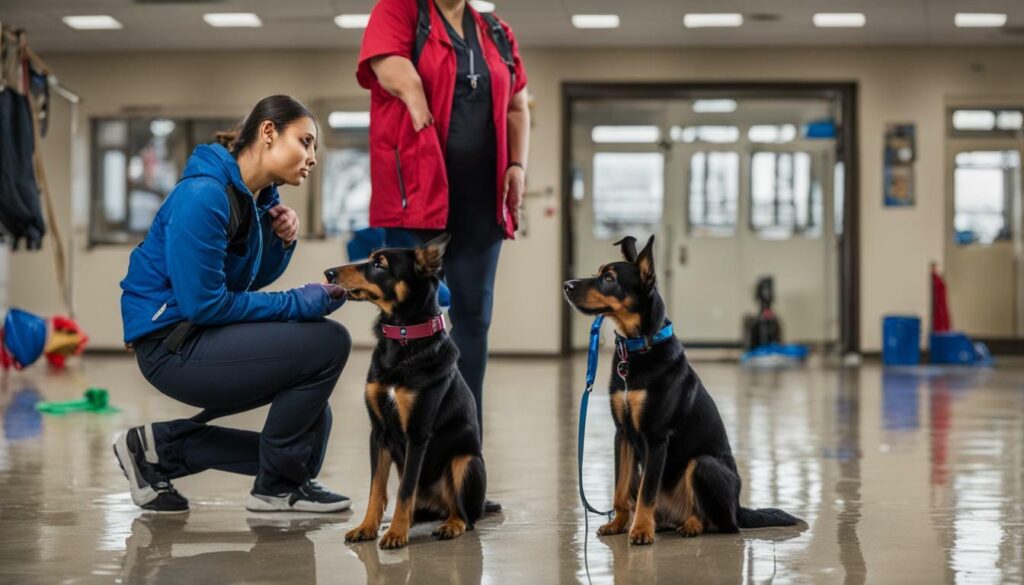
By setting realistic expectations and taking a patient and consistent approach to training, you can improve your chances of success in controlling dog excitement peeing and modifying your dog’s behavior.
Consistency and Positive Reinforcement
Consistency is crucial when training a dog not to excitedly pee. Dogs thrive on routines, so it’s important to establish a consistent training approach and schedule. This means training your dog at the same time every day and in the same location to help them understand what is expected of them.
When using positive reinforcement, it’s important to reward your dog immediately after they exhibit the desired behavior. This reinforces the behavior and increases the likelihood of them repeating it in the future.
Dogs also respond well to verbal praise, so be sure to use a happy and excited tone of voice when praising them. Additionally, giving your dog treats or their favorite toy as a reward can be effective in encouraging desired behaviors.
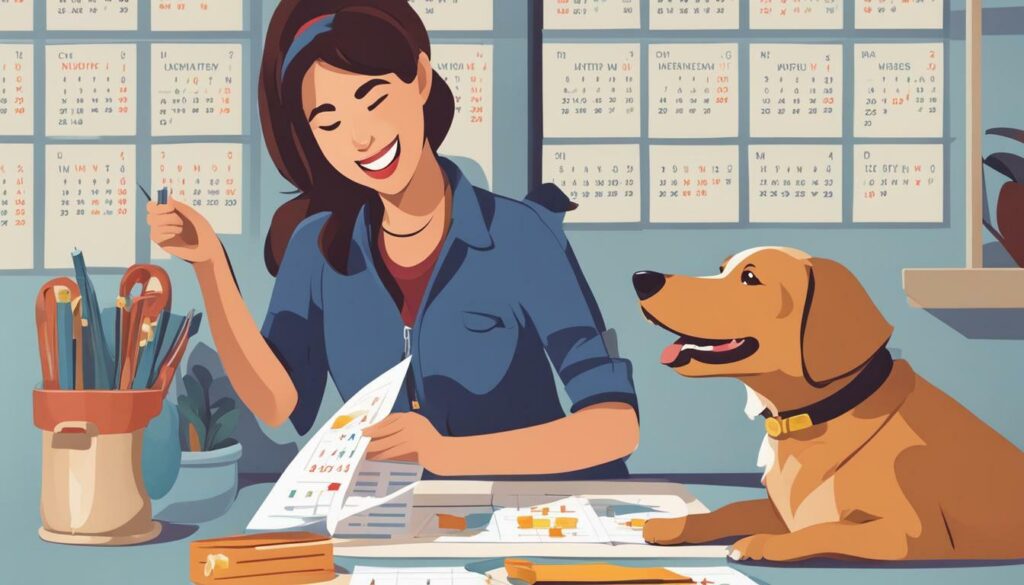
Remember, punishment and scolding are not effective training techniques. Yelling or punishing your dog will only cause fear and confusion, which can lead to further behavior issues.
Consistency and Positive Reinforcement Tips:
- Use the same command or cue for your dog each time you want them to exhibit the desired behavior.
- Set realistic goals and take things one step at a time.
- Keep training sessions short and frequent, rather than long and infrequent.
- Be patient and don’t give up if progress is slow.
- After a few successful repetitions of the desired behavior, gradually increase the level of distraction in the environment to help your dog generalize the behavior to different situations.
Establishing a Bathroom Routine
A consistent bathroom routine is essential for housebreaking and preventing accidents. Dogs thrive on routine, and establishing a consistent schedule will help them learn when and where to go potty.
Start by taking your dog out first thing in the morning, after meals, before bed and whenever they display signals that they need to go, such as sniffing around or circling. Use a specific cue, such as “go potty,” to encourage your dog to relieve themselves.
When your dog does go potty outside, be sure to praise and reward them with a treat or extra attention. This positive reinforcement will help to reinforce their good behavior and encourage them to continue going potty outside.
If your dog has an accident inside, clean it up thoroughly and avoid punishing them. Punishing your dog for accidents can create fear and anxiety, making it more difficult for them to learn proper bathroom habits.
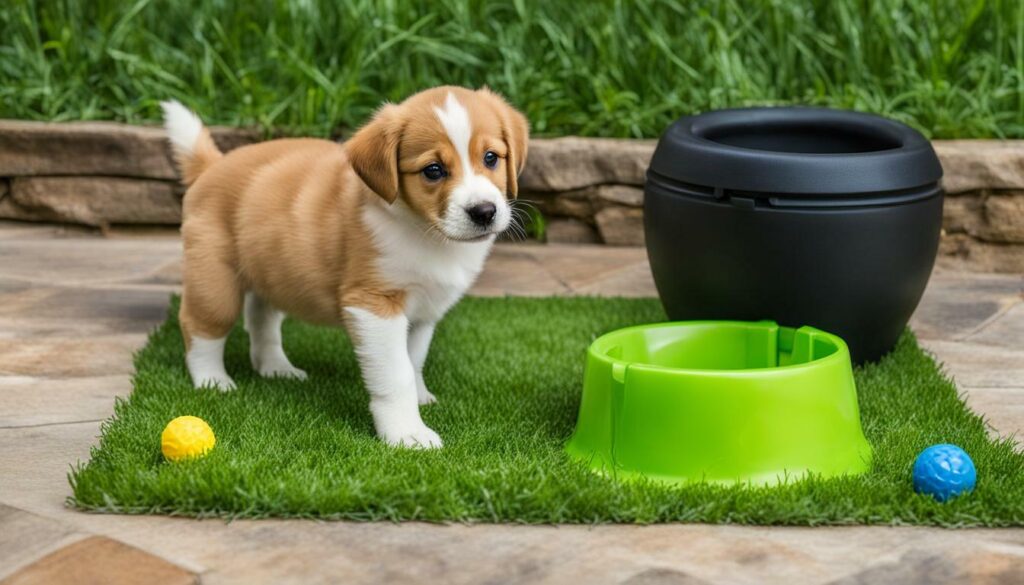
Consistency and patience are key when establishing a bathroom routine. Stick to a schedule as much as possible and be patient with your dog as they learn. With time and practice, your dog will learn when and where to go potty, making accidents a thing of the past.
Managing Excitement Levels
Managing your dog’s excitement levels is one of the most important steps in preventing excited peeing and achieving behavior modification. It’s crucial to identify situations that trigger your dog’s excitement and manage their response to those situations.
One way to manage excitement levels is to avoid overly exciting situations when possible. If your dog gets overly excited when visitors come to the door, for example, you may want to keep them in a separate room until the excitement has died down. This will help prevent accidents and provide a more controlled environment for training.
Another technique to manage excitement levels is to use distraction. Redirecting your dog’s attention with a toy or treat can help calm them down and prevent excited peeing. You can also use a verbal command, such as “sit” or “down,” to redirect their attention and encourage calm behavior.
Consistency is key in managing excitement levels. Make sure to use the same techniques every time to reinforce good behavior. Over time, your dog will learn to stay calm in exciting situations and avoid accidents.
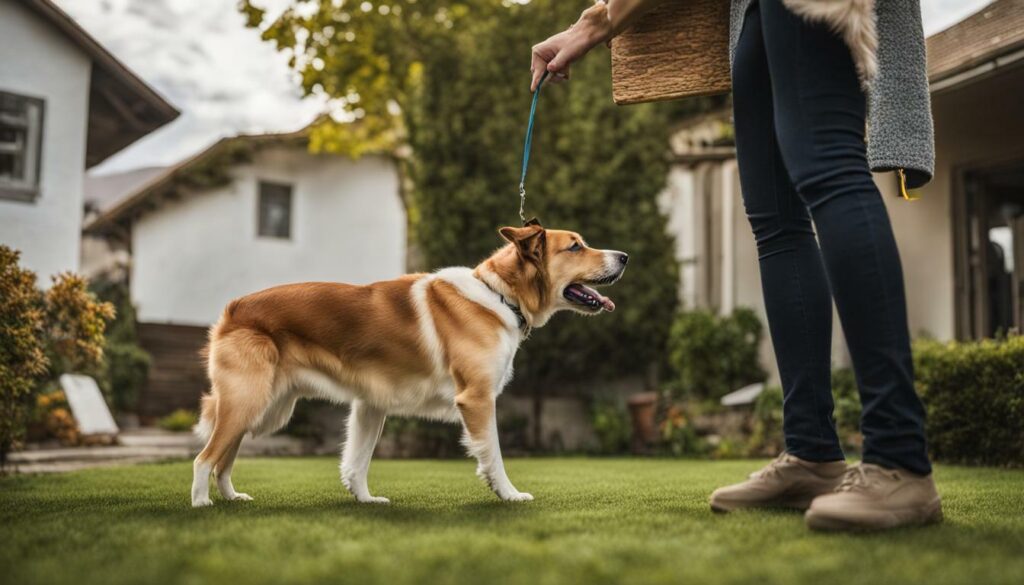
Calming techniques can be effective in preventing excited peeing and submissive urination. By utilizing various methods, you can help your dog stay calm in situations that may trigger accidents. Here are some techniques you can try:
- Aromatherapy: Certain scents can have a calming effect on dogs. Consider using essential oils or sprays, such as lavender or chamomile, to create a calming environment for your dog.
- Soothing Music: Playing soft, soothing music can help relax your dog’s mind and reduce anxiety. Choose music that is specifically designed for dogs, with calming tones and rhythms.
- Anxiety-Reducing Tools: There are several tools available on the market that can help reduce anxiety in dogs, such as calming vests, anxiety wraps, and pheromone sprays. These tools can help provide your dog with a sense of security and comfort in stressful situations.
Introducing calming techniques can take time and patience, but with consistency, you can help your dog feel more at ease and prevent excited peeing and submissive urination.
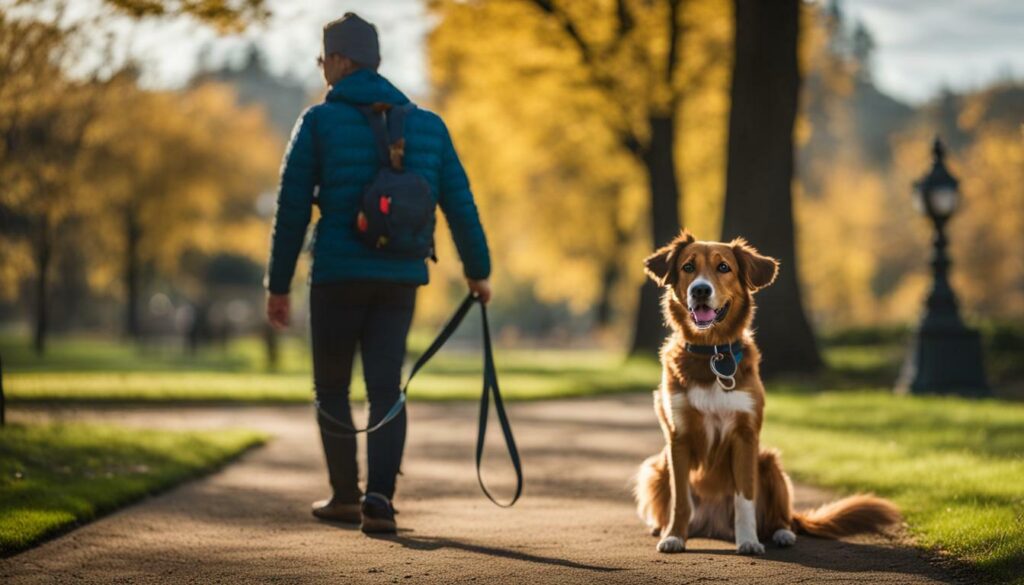
Desensitization and counterconditioning are two behavior modification techniques that can be effective in addressing excitement peeing and submissive urination in dogs. These techniques should only be attempted after your dog has developed a strong foundation in basic obedience training.
Desensitization involves gradually exposing your dog to stimuli that trigger their excitement peeing or submissive urination, starting from a low-intensity level and gradually increasing the intensity as your dog learns to remain calm and composed. This approach involves patience and persistence to gradually desensitize your dog to potential triggers and develop a new, positive emotional response.
Counterconditioning involves changing your dog’s emotional response to a particular stimulus by pairing it with something positive. For example, if your dog gets excited and pees when they see visitors, you can pair the presence of visitors with a delicious treat or a favorite toy. Over time, this can help your dog develop a positive association with visitors and reduce their tendency to excitedly pee.
When practicing desensitization and counterconditioning, it’s important to remain patient and persistent. The process can be slow, but the results are worth it. You should also ensure that you are not inadvertently reinforcing the behavior by responding in a way that reinforces the excitement peeing or submissive urination.

For example, if your dog excitedly pees when they see you come home, avoid getting overly excited, petting your dog, or offering treats until they have calmed down. Instead, wait until they are calm and focused, and then offer praise and rewards to reinforce the desired behavior.
Desensitization and counterconditioning can be complicated and require a lot of patience and work, so it’s a good idea to seek advice from a professional dog trainer or behaviorist before attempting these techniques on your own.
Socialization and Confidence Building
Socialization and confidence-building are key components in reducing excitement peeing. Dogs that are well-socialized and confident are less likely to feel anxious or overwhelmed in new situations, reducing the likelihood of accidents.
One effective way to socialize your dog is by exposing them to various environments, people, and other animals. Start by introducing your dog to different settings, such as parks, streets, and other public areas. Gradually increase the level of exposure as your dog becomes more comfortable.
It’s important to monitor your dog’s behavior during socialization to ensure they are not becoming overly anxious or stressed. If your dog is exhibiting signs of fear or aggression, it’s important to remove them from the situation and provide positive reinforcement for desirable behavior.
In addition to socialization, confidence-building exercises can also be helpful in reducing excitement peeing. Agility training, obedience training, and other activities that involve problem-solving can help your dog build confidence and reduce anxiety.
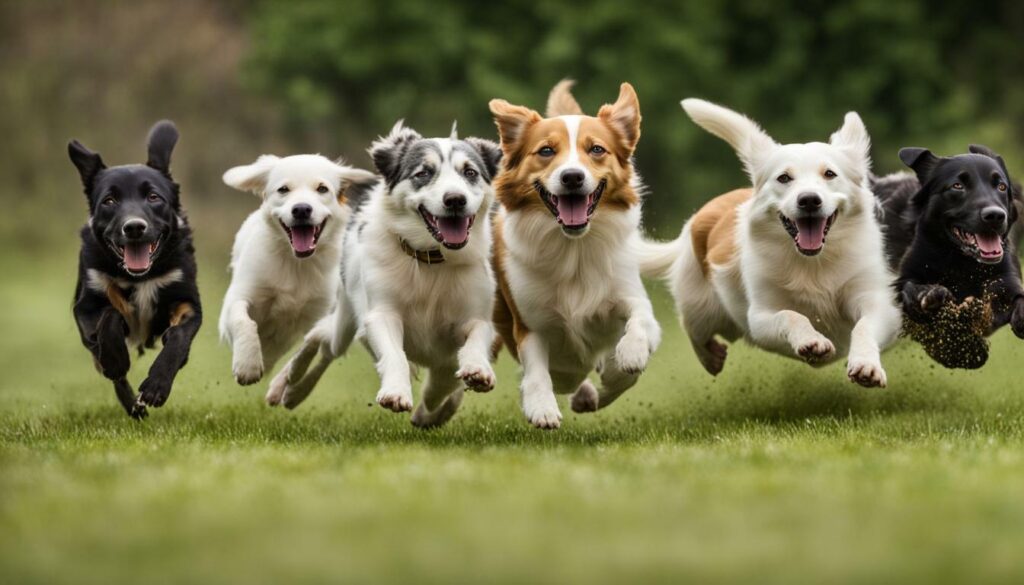
Remember to be patient and persistent during the socialization and confidence-building process. It may take time for your dog to become comfortable in new situations, but with consistent training and positive reinforcement, they can learn to stay calm and avoid excited peeing.
Supervision and Management
Proper supervision and management are crucial during the training process to prevent accidents and reinforce positive behaviors. The following dog training tips can help you stop dog urine accidents:
- Supervise your dog at all times, especially during times of high excitement or in unfamiliar environments.
- Limit your dog’s access to certain areas of your home or yard where accidents have occurred in the past.
- Use management tools, such as baby gates or crates, to keep your dog in a secure and supervised area when necessary.
- Establish a routine for your dog’s feeding and potty schedule to avoid accidents due to hunger or a full bladder.
By following these dog training tips, you can effectively supervise and manage your dog to prevent accidents and promote positive behaviors.
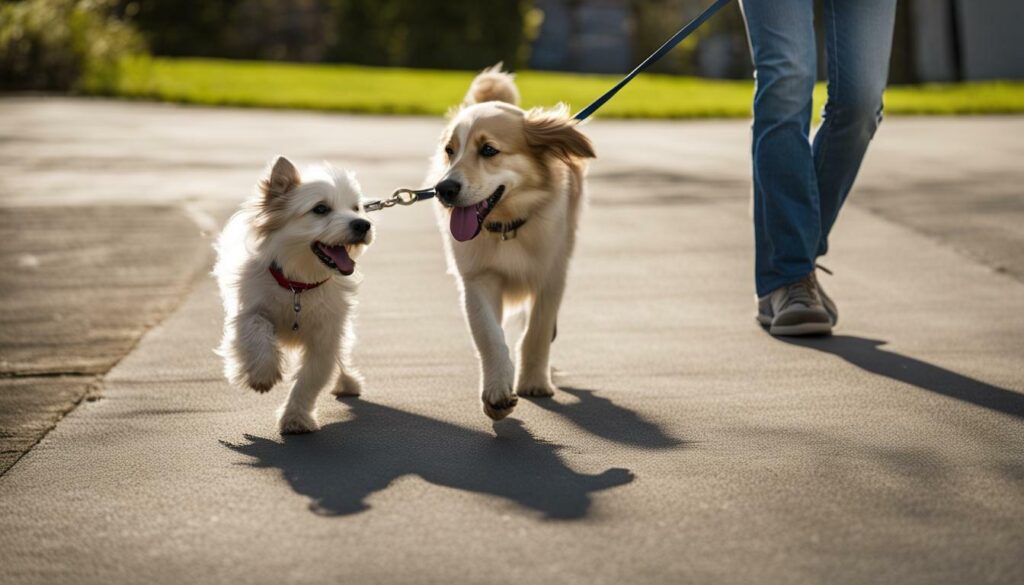
Addressing Submissive Urination
Submissive urination is a common issue in dogs, especially in puppies and those who lack confidence. It’s important to note that submissive urination is not a housebreaking issue but a behavioral issue, and it requires a different approach to training.
The first step in addressing submissive urination is to build your dog’s confidence. Positive reinforcement is key to building confidence in your dog. When your dog displays confident behavior, such as standing tall or wagging their tail, praise and reward them with treats or playtime. Avoid punishing or scolding your dog for submissive urination, as this can worsen the behavior and decrease confidence.
Another effective approach to reducing submissive urination is to avoid situations that trigger submissive behavior. If you know that certain situations, such as meeting new people or animals, trigger submissive urination, gradually introduce your dog to these situations in a controlled and positive manner.
Finally, providing positive reinforcement for desired behaviors can help recondition your dog’s response to trigger situations. For instance, if your dog typically submissively pees when meeting new people, provide positive reinforcement when they greet someone without urinating. Over time, this can help your dog build confidence and reduce submissive urination.
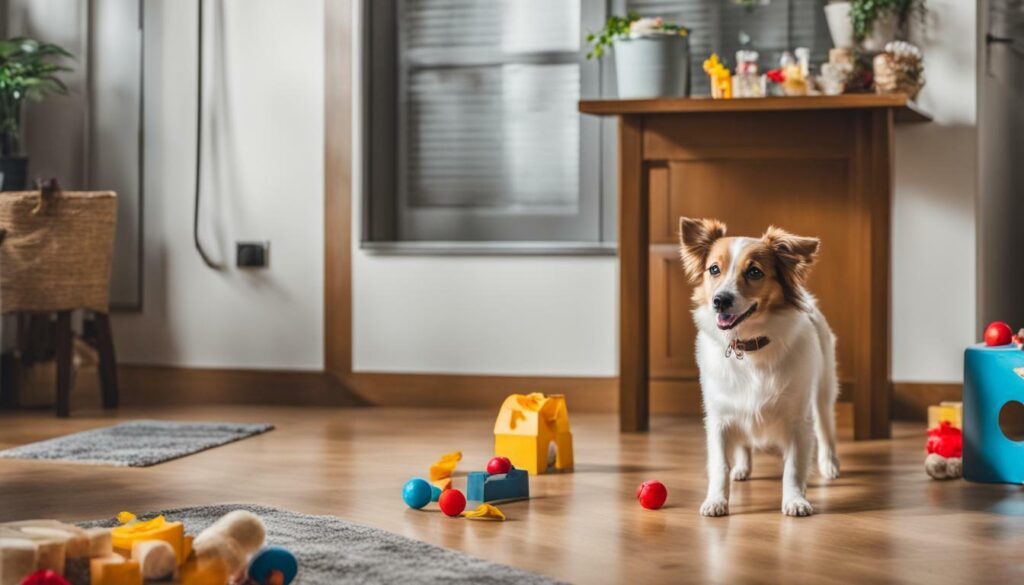
If you have attempted the training techniques outlined in this article, but are still facing challenges in controlling your dog’s excitement peeing or submissive urination, it may be time to seek professional help. A trainer or behaviorist can assess your dog’s specific needs and provide tailored training solutions to address their behavior issues.
It’s important to find a qualified trainer or behaviorist with experience in dog behavior modification. Look for individuals who use positive reinforcement techniques and have a good reputation in the industry. You can check online reviews, ask for recommendations from other dog owners or your veterinarian.
During your consultation with a professional, they may observe your dog’s behavior, provide insight into potential causes, and develop a customized training plan. They will also provide guidance on how to implement the training techniques and monitor progress.
Remember that some behavior issues may require more intensive training or medication to address, and a professional trainer or behaviorist can help you determine the best course of action.
Consulting a professional can be an investment, but it can also provide long-term benefits for you and your dog. With their expertise and guidance, you can successfully overcome your dog’s excitement peeing or submissive urination and maintain a positive, healthy relationship with your furry companion.
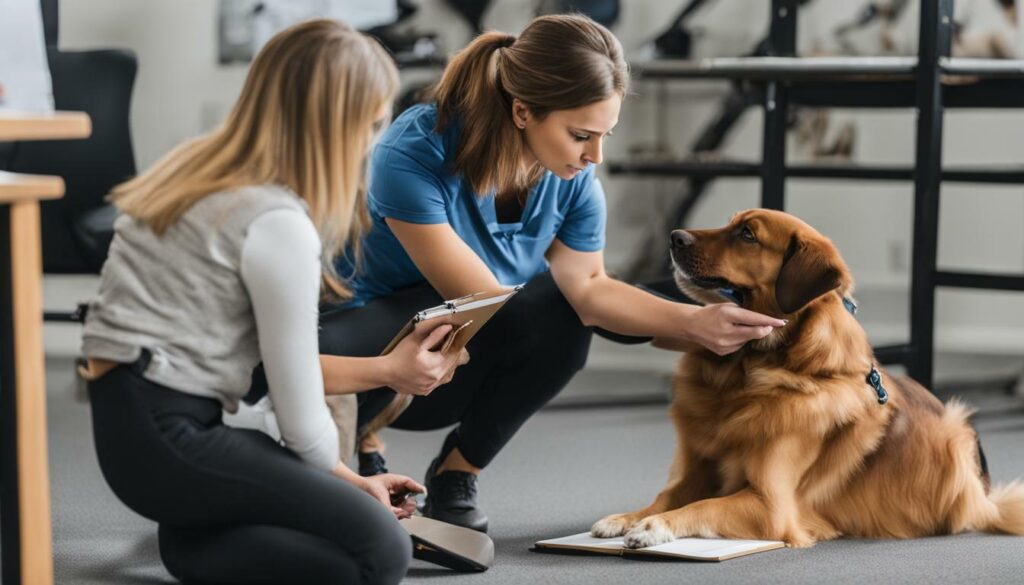
Training a dog not to excitedly pee requires patience, persistence, and consistency. Here are some do’s and don’ts to keep in mind:
- Do: Establish a consistent routine and stick to it. Dogs thrive on predictability, so having a set schedule for potty breaks, meals, and playtime can help them feel secure and reduce accidents.
- Don’t: Punish your dog for accidents. Punishment can create fear and anxiety, which can worsen the problem and damage your relationship with your pet.
- Do: Use positive reinforcement techniques, such as treats, praise, and playtime, to encourage desired behaviors. Dogs respond well to positive feedback and are more likely to repeat behaviors that are rewarding.
- Don’t: Use physical punishment or harsh training methods. These can harm your dog both physically and emotionally, and may lead to more behavior problems down the road.
- Do: Be patient and persistent. Training takes time and effort, but with consistency and a positive attitude, you can achieve success.
- Don’t: Give up too soon. It’s normal to experience setbacks and challenges during the training process, but with persistence and commitment, you can overcome them and achieve your goals.
- Do: Monitor your dog’s behavior and adjust your training approach as needed. Every dog is different, so it’s important to pay attention to their individual needs and make necessary changes to your training plan.
- Don’t: Neglect supervision and management. Even a well-trained dog may have accidents if they are not properly supervised or managed, so be sure to monitor your dog’s behavior and limit their access to areas where accidents are likely to occur.
By following these do’s and avoiding these don’ts, you can effectively train your dog not to excitedly pee and prevent urine accidents in your home. Remember to stay positive, patient, and persistent, and seek professional help if you need it.
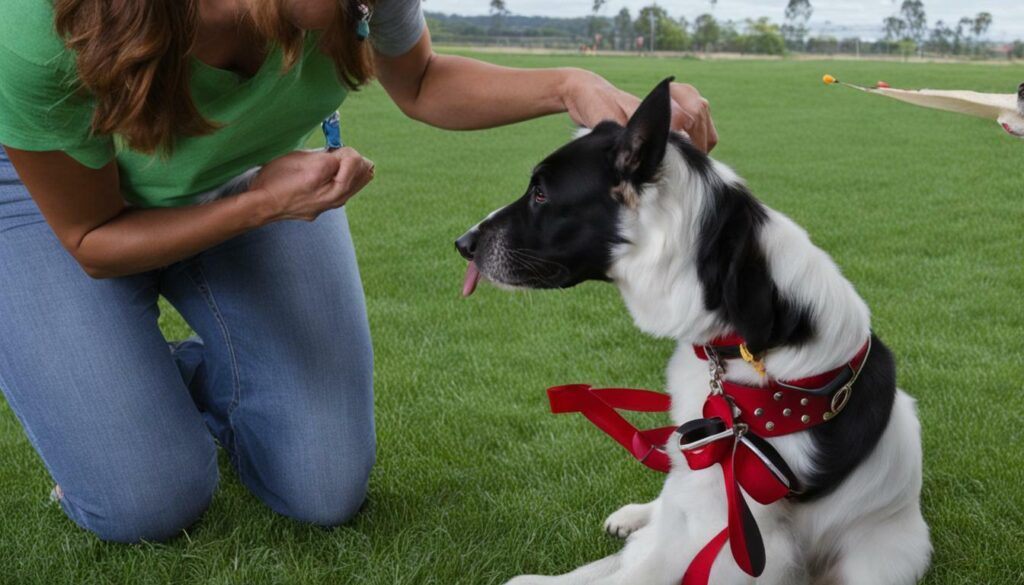
Training a dog not to excitedly pee requires a specific approach that can yield excellent results. However, there are certain things that you should and shouldn’t do to ensure a positive outcome. Here are some of the do’s of training:
- Establish a consistent routine for your dog, including regular potty breaks and mealtimes.
- Use positive reinforcement techniques, such as treats and verbal praise, to reward good behavior.
- Stay calm and patient with your dog, even when accidents occur.
- Use behavior modification techniques, such as desensitization and counterconditioning, to modify unwanted behaviors.
- Consult a professional trainer or behaviorist if you’re facing challenges in training your dog.
On the other hand, here are some of the don’ts of training:
- Avoid punishing your dog for accidents or unwanted behavior, as this can cause anxiety and stress.
- Don’t yell or physically harm your dog as a means of discipline, as this can be counterproductive and detrimental to their overall well-being.
- Don’t expect immediate results, as training takes time and patience.
- Avoid using harsh or aversive training methods, as these can cause more harm than good.
By following these tips, you can ensure a successful training process that strengthens the bond between you and your furry friend. Remember, patience and consistency are key in training a dog not to excitedly pee.
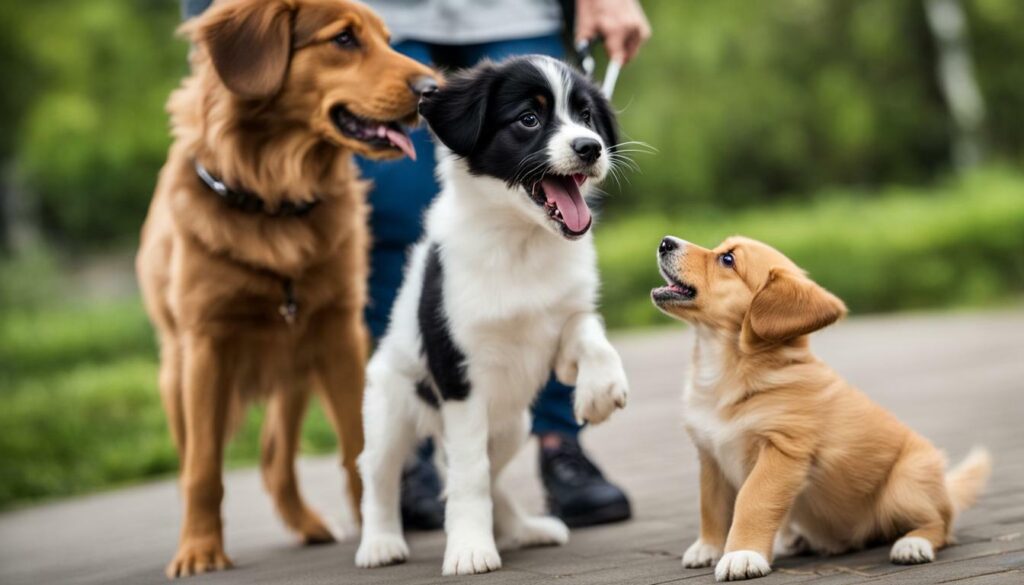
Training a dog not to excitedly pee is a process that requires patience and persistence. It’s important to remember that every dog is different and may require their own unique approach to training. Some dogs may respond quickly to training, while others may take longer to see results. It’s important to stay consistent and patient with your dog’s progress.
When starting the training process, it’s essential to establish a routine and stick to it. Consistency is key to successful training. It’s also important to remember that positive reinforcement is more effective than punishment. Reward your dog for good behaviors and ignore or redirect undesirable behaviors.
It’s important to keep in mind that training is an ongoing process. Even after your dog has learned not to excitedly pee, you’ll need to continue to reinforce their good behavior and practice management techniques to avoid accidents. Celebrate your dog’s successes along the way and acknowledge their progress.
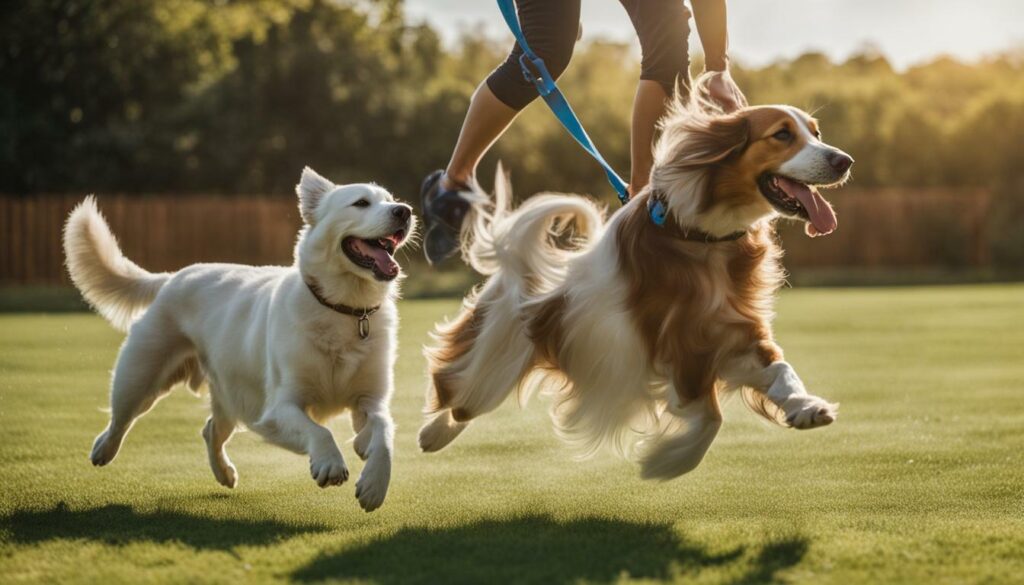
Remember, training a dog not to excitedly pee takes time, effort, and patience. Consistency and positive reinforcement are key to success. It’s essential to be persistent with your training and celebrate your dog’s progress as you continue to reinforce good behaviors. With patience and practice, you can successfully train your dog to avoid excited peeing and ensure a happy, pee-free home.
Conclusion
Training your dog not to excitedly pee requires dedication and the use of a systematic approach. The steps outlined in this article are essential for ensuring your furry friend greets you with a pee-free welcome. Following expert tips on dog training, utilizing techniques to prevent urine marking, and understanding your dog’s individual needs are key elements for controlling excitement peeing and eliminating submissive urination accidents.
Consistency and positive reinforcement are crucial when training your dog. Establishing a bathroom routine, managing excitement levels, and introducing calming techniques are also effective strategies for controlling excitement peeing. Desensitization, counterconditioning, socialization, and confidence-building are behavior modification techniques that can help your dog overcome pee-related issues.
Proper supervision and management are necessary during the training process, and it’s important to be aware of the do’s and don’ts. If you’re facing challenges in training your dog not to excitedly pee, seeking help from a professional trainer or behaviorist can be beneficial. Patience and persistence are essential for successfully training your dog and celebrating their success.
By following these tips and techniques, you can maintain consistent training to ensure that your furry friend continues to refrain from excited peeing. Thank you for reading and we hope that these tips will help you and your furry friend have a happy and healthy relationship.
FAQ
Q: What are some common causes of excited peeing in dogs?
A: Excited peeing in dogs can be caused by a variety of factors, including lack of bladder control, fear, anxiety, or overstimulation. It is important to understand the underlying cause in order to address the behavior effectively.
Q: How can I prevent my dog from excitedly peeing?
A: Prevention techniques include managing your dog’s excitement levels, establishing a consistent bathroom routine, using positive reinforcement, and desensitization and counterconditioning techniques. These methods can help your dog learn alternative behaviors and reduce the likelihood of accidents.
Q: Is submissive urination the same as excited peeing?
A: Submissive urination is a different behavior than excited peeing. Submissive urination typically occurs when a dog feels intimidated or wants to show submission. It is important to address both behaviors separately and tailor the training approach accordingly.
Q: How long will it take to train my dog not to excitedly pee?
A: The length of time it takes to train your dog not to excitedly pee can vary depending on various factors, including your dog’s individual temperament, previous training experiences, and the consistency of your training efforts. It is important to be patient and persistent throughout the training process.
Q: Should I consult a professional trainer or behaviorist for help?
A: If you are facing challenges in training your dog not to excitedly pee, consulting a professional trainer or behaviorist can be beneficial. They can assess your dog’s specific needs and provide tailored training solutions to address the behavior effectively.
Q: Are there any do’s and don’ts I should be aware of during the training process?
A: Yes, there are some important do’s and don’ts to keep in mind during the training process. It is important to be consistent, use positive reinforcement, avoid punishment or scolding, and set realistic expectations. Additionally, it is crucial not to reinforce excited peeing by getting angry or showing frustration.
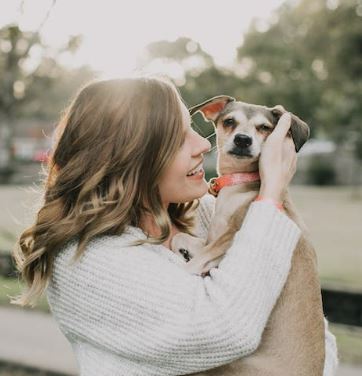
Marissa Delotta, 36, from Dayton, Ohio, is the creative force behind Roverboard.com, a beloved online destination for dog lovers. As a dedicated mom and canine enthusiast, Marissa combines her family experiences with her love for dogs to offer a platform where dog owners can exchange tips, heartwarming stories, and advice. Her website has become a vibrant community for sharing the joys of dog parenting. In her free time, Marissa enjoys exploring dog parks with her family and volunteering at local animal shelters.